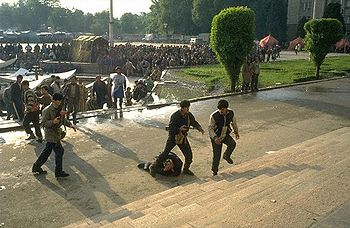
Dushanbe riots
Encyclopedia

Dushanbe
-Economy:Coal, lead, and arsenic are mined nearby in the cities of Nurek and Kulob allowing for the industrialization of Dushanbe. The Nurek Dam, the world's highest as of 2008, generates 95% of Tajikistan's electricity, and another dam, the Roghun Dam, is planned on the Vakhsh River...
, the capital of the Tajik SSR
Tajik SSR
The Tajik Soviet Socialist Republic , also known as the Tajik SSR for short, was one of the 15 republics that made up the Soviet Union. Located in Central Asia, the Tajik SSR was created on 5 December 1929 as a national entity for the Tajik people within the Soviet Union...
, from February 12–14, 1990.
In 1988, in the aftermath of the Sumgait pogrom
Sumgait Pogrom
The Sumgait pogrom was a pogrom that targeted the Armenian population of the seaside town of Sumgait in Soviet Azerbaijan during February 1988...
and anti-Armenian riots in the Azerbaijan SSR
Azerbaijan SSR
The Azerbaijan Soviet Socialist Republic , also known as the Azerbaijan SSR for short, was one of the republics that made up the former Soviet Union....
, 39 Armenian
Armenians
Armenian people or Armenians are a nation and ethnic group native to the Armenian Highland.The largest concentration is in Armenia having a nearly-homogeneous population with 97.9% or 3,145,354 being ethnic Armenian....
refugees were temporarily resettled from Azerbaijan
Azerbaijan
Azerbaijan , officially the Republic of Azerbaijan is the largest country in the Caucasus region of Eurasia. Located at the crossroads of Western Asia and Eastern Europe, it is bounded by the Caspian Sea to the east, Russia to the north, Georgia to the northwest, Armenia to the west, and Iran to...
to Dushanbe
Dushanbe
-Economy:Coal, lead, and arsenic are mined nearby in the cities of Nurek and Kulob allowing for the industrialization of Dushanbe. The Nurek Dam, the world's highest as of 2008, generates 95% of Tajikistan's electricity, and another dam, the Roghun Dam, is planned on the Vakhsh River...
. In 1990, the Armenian influx became a subject of the rumour that triggered riots in Dushanbe. The rumour inflated the number of refugees to 2,500–5,000. According to rumour Armenians allegedly were being resettled in new housing in Dushanbe experiencing acute housing shortage at that time. Despite the fact that Armenian refugees resettled not in public housing but with their relatives, and by 1990 already left Tajikistan
Tajikistan
Tajikistan , officially the Republic of Tajikistan , is a mountainous landlocked country in Central Asia. Afghanistan borders it to the south, Uzbekistan to the west, Kyrgyzstan to the north, and China to the east....
for Armenia
Armenia
Armenia , officially the Republic of Armenia , is a landlocked mountainous country in the Caucasus region of Eurasia...
, official denouncement of the rumours was not able to stop the protests. Assurances by Communist Party
Communist party
A political party described as a Communist party includes those that advocate the application of the social principles of communism through a communist form of government...
First Secretary
General Secretary
The office of general secretary is staffed by the chief officer of:*The General Secretariat for Macedonia and Thrace, a government agency for the Greek regions of Macedonia and Thrace...
Ghagar Makhkamov that no resettlement of Armenians was taking place were rejected by the demonstrators Soon, demonstrations sponsored by the nationalist Rastokhez
Rastokhez
The Rastokhez party was a political party in Tajikistan in the years of independence and civil war .It was founded on September 14, 1989, by members of the Tajik intelligentsia, among them Tohir Abdujabbor, with a moderate nationalist and democratic program.Its prominent position in the opposition...
movement turned violent. Radical economical and political reforms were demanded by the protesters. Government buildings, shops and other businesses were attacked and looted. Armenians, Russians, and other ethnic minorities were targeted. Abuse of Tajik women wearing European clothes in public also took place. The riots were put down by Soviet troops that were called into Dushanbe by Ghagar Makhkamov. However Makhamov's over reliance on military force was criticized by Buri Karimov, a deputy chair of Council of Ministers, who called for the resignation of the leadership of the Tajik Communist Party. On February 14, 1990 Makhamov and Prime Minister of Tajik SSR Ezatolloh Khayeyev submitted their resignations, but they were not accepted by the Central Committee of the Tajik Communist Party.
During the Dushanbe riots, a period lasting a couple of days, 22 people were killed and 565 were injured. Among the Tajik youth activists convicted for participation in the riots was a future minister of the interior of Tajikistan
Tajikistan
Tajikistan , officially the Republic of Tajikistan , is a mountainous landlocked country in Central Asia. Afghanistan borders it to the south, Uzbekistan to the west, Kyrgyzstan to the north, and China to the east....
Yakub Salimov
Yakub Salimov
Yaqub Salimov is a former minister of the interior of Tajikistan.In 1990 Yaqub Salimov was convicted for taking part in Dushanbe riots. When Tajik Civil War broke out, Salimov was released from prison, and become a leader of Popular Front, a paramilitary group fighting on the government side. In...
.
Smaller scale anti-Armenian incidents were also recorded in another Soviet Central Asian Republic, the Turkmen SSR
Turkmen SSR
The Turkmen Soviet Socialist Republic , also known as the Turkmen SSR for short, was one of republics of the Soviet Union in Central Asia. It was initially established on 7 August 1921 as the Turkmen Oblast of the Turkestan ASSR. On 13 May 1925 it was transformed into Turkmen SSR and became a...
.

